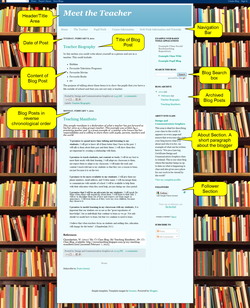Blogs: Online Journals
What is a Blog?
A blog is a form of online journal. Blogs offer your pupils an area to reflect on their learning, upload work for review, and many other very useful applications. You may say, "why not just keep a paper journal?", the simple answer to this is that blogs allow for the use of text, images, links and video which an everyday journal could never wish to incorporate. Allowing pupils to include text, images, links and even video means that they can express their views and feelings in a very rich and varied way that best expresses their learning.
Below is a very simple description, produced by commoncraft.com, of what a blog is and what it can be used for
Below is a very simple description, produced by commoncraft.com, of what a blog is and what it can be used for
Layout of a Typical Blog
How can you use blogs in your classroom?
Using blogs in your classroom will open many doors to you and your pupils in terms of the collaboration and communication you can achieve with pupils and parents. Possible uses of blogs include:
- A common online presence for class information such as calendars, events, assignments and resources
- An online area for students to post queries relating to assessment or any part of classroom environment
- Comments based on content, and students responses
- A collaborative space for students to act as reviewers for course-related materials as well as peer review of work
- Images and reflections related to all aspects of school
- An online gallery space for review class work
- Teachers encouraging reactions, reflections and ideas by commenting on their students’ blogs
- The development of a student portfolio of work (ePortfolios)
What Affordances do blogs offer you and your pupils?
Blogs can offer you and your pupils all of the affordances that McLoughlin and Lee (2007) saw, these included, “connectivity and social rapport, collaborative information discovery and sharing, content creation, knowledge and information aggregation”. Lets look at them a little closer
1. Connectivity and Social Rapport
2. Collaborative Information Discovery and Sharing
3. Content Creation
4. Knowledge and Information Aggregation
1. Connectivity and Social Rapport
- This is perhaps the most important affordance of blogs as learning is a social activity
- Blogs allow this sociability by allowing people to subscribe to other people’s blogs and a large part of blogging is giving and receiving comments on blog posts.
- According to Jonassen et al. (1999) blogs have, “the potential to both liberate and tie learners together” which in turn can create, “dynamic learning communities” (Boulos et al. 2006).
- As so many pupils are actively social on the internet already (e.g. Facebook) it is obvious that your pupils crave connectivity and the ability to socialise on the internet and blogs are a means of doing this.
2. Collaborative Information Discovery and Sharing
- The main way that blogs can be used for “collaborative information discovery and sharing” is by placing useful links to other websites on blogs and also becoming a “follower” of a blog to enable people to see when new content has been added.
3. Content Creation
- Creating content is the premise of blogging. Blogging allows pupils to add new information to their blog quickly and easily.
4. Knowledge and Information Aggregation
- Blogs allow your pupils to collect all of the knowledge and content that they have created themselves and find even more knowledge on other pupils' blogs around the world to create large learning communities online.
Sample Class Blogging Activities
Tools Available
There are many different blogging platforms in operation today. It is important to look at each to see which blogging tool best suits your situation. The most established blogging software tools available are:
I would recommend using:
http://www.edublogs.org
Alternatively their are:
I would recommend using:
http://www.edublogs.org
Alternatively their are:
References
Boulos, M. N., Maramba, I. and Wheeler, S. (2006) 'Wikis, blogs and podcasts: a new generation of Web-based tools forvirtual collaborative clinical practice and education', BMC medical education, 6(1), 41.
This website has been created by Paul Leacy (0744034) in 2011 as part of his Final Year Project in the University of Limerick as part of the (B.Tech. Ed.) course in Materials and Construction Technology.









